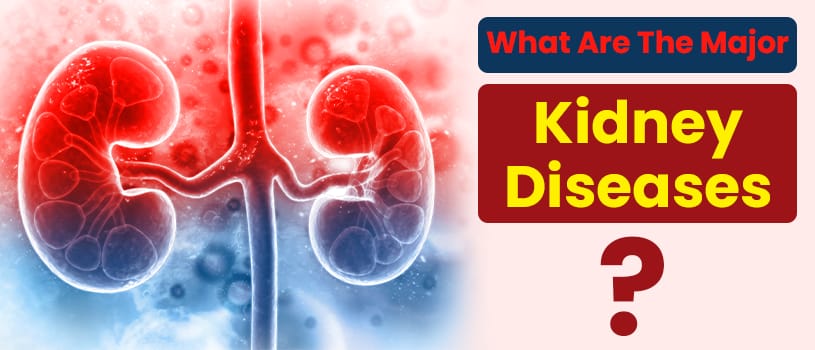What is kidney disease?
Two fist-sized organs at the base of the rib cage are the kidneys. A kidney can be found on either side of the spine. Kidney function is critical to maintaining a healthy body. They have the task to remove waste products, excess water and other harmful things from the bloodstream. Toxins are aggregated in the bladder and then eliminates by urination.
Different types of kidney disease –
Chronic kidney disease:
Chronic renal disease is very common among various kidney diseases. Chronic kidney disease is persistent illness that does not cure on its own. High blood pressure is a common reason because it can put too much strain on the glomeruli in the kidneys that cause them to operate inefficiently.
Kidney function will gradually reach to the point that it will be unable to operate correctly as required. Dialysis would be required in this situation. Dialysis reduces the waste and extra fluid from the bloodstream. A kidney transplant is another treatment option. Diabetic nephropathy is a common diabetic consequence.
Kidney stones:
Another common kidney ailment is kidney stones. This is the solid small particles when minerals and other chemicals in the blood crystallize there. Kidney stones are generally passed through stool or urination. Kidney stones can be excruciatingly painful to pass, although they seldom cause serious complications.
Glomerulonephritis:
Glomerulonephritis is a condition that causes glomeruli to inflame. Glomeruli are tiny blood-filtering structures located or remains inside the kidneys. Infections, medications, and congenital anomalies can all cause glomerulonephritis (disorders that occur during or shortly after birth). It usually improves on its own.
Polycystic kidney disease:
PKD is a genetic illness that causes kidneys to develop multiple cysts or small sacs of fluid. This cause renal failure by encroaching in the kidney functions. (It’s worth noting that individual kidney cysts are fairly common and nearly always benign.) Polycystic kidney disease, on the other hand, is a different, more dangerous disorder.)
Urinary tract infections:
Urinary tract infections (UTIs) are bacterial diseases that affect the urinary system and can spread to other parts of the body. The most prevalent are bladder and urethra infections. They are easily curable and rarely does it result in additional health issues. These infections can move to the kidneys and cause renal disease if left untreated.
What are the symptoms of kidney disease?
Kidney disease is a condition that can easily go unrecognized and undetectable until the symptoms become severe. The following symptoms like fatigue, trouble sleeping, muscle cramping, etc. are early warning indications indicating you might have kidney disease.
How is kidney disease diagnosed?
Your doctor will first evaluate if you fall into one of the high-risk categories. They’ll then perform some tests to see if your kidneys are in good working order. GFR, CT Scan, kidney biopsy, and urine test are examples of these assays.
How is kidney disease treated?
Kidney disease treatment usually focuses on addressing the disease’s underlying cause. This means that your doctor will work with you to improve the way you manage your blood pressure, blood sugar, and cholesterol levels. To treat renal illness, they may employ one or more of the following methods: medications or medication, dietary changes, and lifestyle changes.
Dialysis and kidney disease
Dialysis is a procedure of filtering blood that is performed artificially. It’s prescribed when a person’s kidneys have failed or are on the verge of failing. Many people with advanced renal disease must undergo dialysis for the rest of their lives or until a donor’s kidney can be obtained.
There are two types of dialysis:-
1. Hemodialysis
Hemodialysis involves pumping blood through a machine that filters out waste materials and excess fluid. Hemodialysis can be performed at home, in a hospital, or at dialysis centers.
2. Peritoneal dialysis
A tube is implanted and used to fill the abdomen with a fluid called dialysate in peritoneal dialysis. Waste materials in the peritoneum’s circulation flow into the dialysate. After that, the dialysate is emptied from the abdomen.
Continuous ambulatory peritoneal dialysis, in which the belly is filled and drained multiple times throughout the day, and continuous cycler-assisted peritoneal dialysis, in which a machine cycles the fluid in and out of the abdomen while the person sleeps, are the two types of peritoneal dialysis.
Long term outlook for people with kidney disease
Once kidney disease is detected, it usually does not go away. The best method to keep your kidneys healthy is to live a healthy lifestyle and listen to your doctor. Kidney disease has the potential to worsen over time. It could potentially result in renal failure. If kidney failure is not addressed, it can be fatal. When your kidneys are hardly functional or not working at all, you have renal failure. Dialysis is used to control this. Dialysis is the process of filtering waste from your blood using a machine. Your doctor may suggest a kidney transplant in some instances.
Limit certain foods
Different types of chemicals in your food that can contribute to the stones in the kidney. These include sodium, proteins, acid-based foods, oxalate, and calcium.

